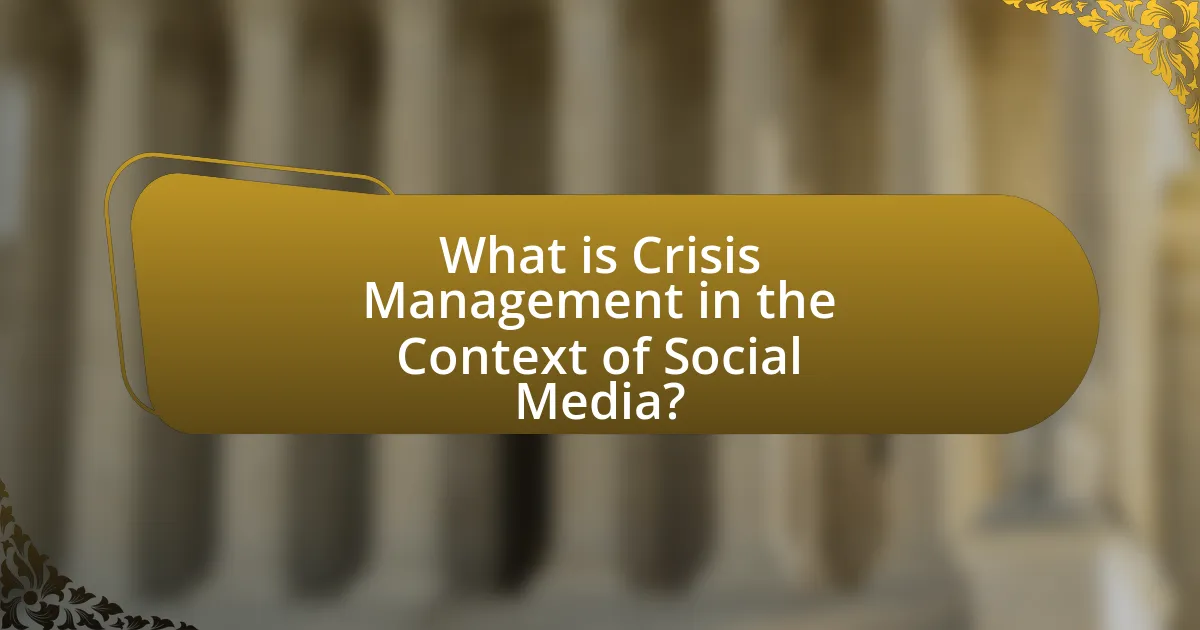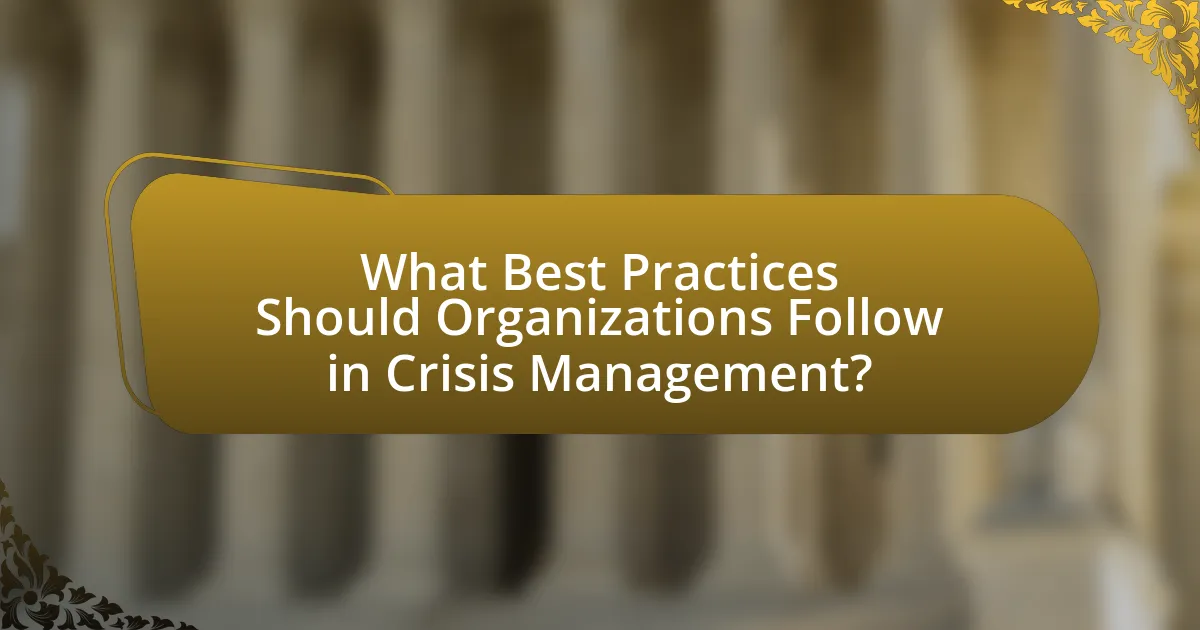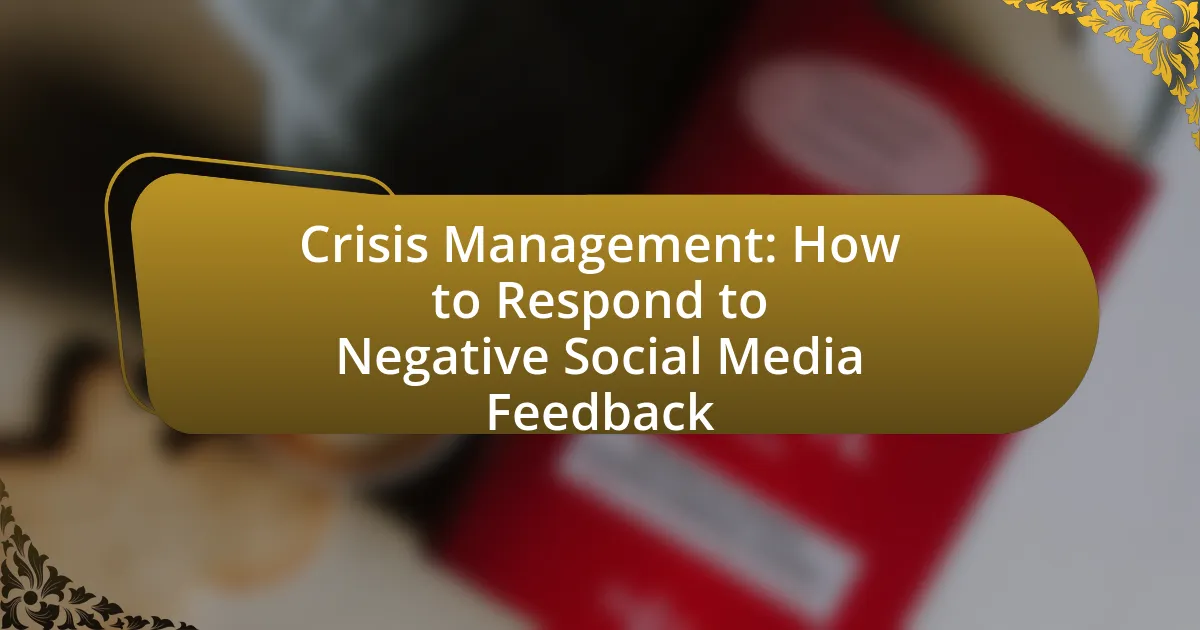Crisis management in the context of social media involves strategies and actions organizations take to address negative situations that arise on social platforms. The article explores the impact of negative feedback on brand reputation and customer trust, highlighting the importance of timely responses and effective communication strategies. It outlines common types of negative feedback, the potential escalation into crises, and the key steps organizations should take to manage such situations. Additionally, best practices for crisis management, including the establishment of a crisis communication plan and employee training, are discussed to enhance organizational preparedness and response effectiveness.

What is Crisis Management in the Context of Social Media?
Crisis management in the context of social media refers to the strategies and actions taken by organizations to address and mitigate negative situations that arise on social media platforms. This involves monitoring social media channels for potential crises, responding promptly to negative feedback or misinformation, and implementing communication strategies to restore public trust. Effective crisis management on social media is crucial, as studies show that 78% of consumers expect a response from brands within an hour of posting a complaint.
How does negative feedback on social media impact organizations?
Negative feedback on social media significantly impacts organizations by damaging their reputation and customer trust. When consumers express dissatisfaction publicly, it can lead to a rapid decline in brand perception, as studies show that 70% of consumers trust online reviews as much as personal recommendations. This negative sentiment can result in decreased sales, as potential customers may choose competitors with better reputations. Furthermore, organizations may face increased scrutiny from the media and stakeholders, leading to potential financial repercussions. For instance, a 2019 study by the Harvard Business Review found that companies experiencing negative social media backlash saw a 20% drop in stock prices within a week. Thus, the repercussions of negative feedback on social media are profound, affecting both immediate consumer behavior and long-term organizational viability.
What are the common types of negative feedback encountered?
Common types of negative feedback encountered include criticism, complaints, and negative reviews. Criticism often arises from dissatisfaction with a product or service, highlighting specific issues that customers face. Complaints typically involve direct expressions of discontent, often communicated through social media platforms, where users seek resolution or acknowledgment. Negative reviews are public assessments that can significantly impact a brand’s reputation, as they reflect the experiences of customers and can influence potential buyers. These forms of feedback are crucial for organizations to address, as they provide insights into customer perceptions and areas for improvement.
How can negative feedback escalate into a crisis?
Negative feedback can escalate into a crisis when it triggers widespread public outrage or dissatisfaction, often amplified by social media. For instance, a single negative review can lead to a viral backlash if it resonates with a larger audience, resulting in significant reputational damage. According to a study by the Harvard Business Review, 70% of consumers are influenced by online reviews, meaning that negative feedback can quickly gain traction and lead to a loss of customer trust. If not addressed promptly and effectively, this can snowball into a full-blown crisis, impacting sales and brand loyalty.
Why is effective crisis management crucial for brands?
Effective crisis management is crucial for brands because it helps mitigate damage to reputation and maintain customer trust during adverse situations. When a crisis occurs, brands that respond swiftly and transparently can prevent escalation and negative public perception. For instance, a study by the Institute for Crisis Management found that 70% of companies that effectively manage crises recover their reputation within a year, compared to only 30% of those that do not. This demonstrates that proactive and strategic crisis management not only protects a brand’s image but also fosters long-term customer loyalty.
What are the potential consequences of ignoring negative feedback?
Ignoring negative feedback can lead to significant reputational damage for an organization. When negative feedback is overlooked, it can escalate customer dissatisfaction, resulting in a loss of trust and loyalty among consumers. Research indicates that 70% of customers are more likely to share their negative experiences with others, amplifying the impact of the ignored feedback. Additionally, failure to address concerns can lead to a decline in sales, as potential customers may choose competitors who are perceived as more responsive and attentive to consumer needs. Ultimately, ignoring negative feedback can create a cycle of worsening public perception and decreased market share.
How can effective management of feedback enhance brand reputation?
Effective management of feedback enhances brand reputation by fostering trust and demonstrating responsiveness to customer concerns. When brands actively engage with feedback, particularly negative comments, they show that they value customer opinions and are committed to improving their products or services. Research indicates that 70% of consumers are more likely to recommend a brand that responds to feedback, highlighting the importance of engagement in building a positive image. Additionally, addressing issues publicly can mitigate potential crises, as timely responses can prevent escalation and showcase a brand’s dedication to customer satisfaction. This proactive approach not only improves customer loyalty but also attracts new customers who appreciate transparency and accountability.

What are the Key Steps in Responding to Negative Social Media Feedback?
The key steps in responding to negative social media feedback include acknowledging the issue, assessing the situation, crafting a thoughtful response, and following up. Acknowledging the issue demonstrates that the organization values customer feedback and is attentive to concerns. Assessing the situation involves understanding the context and severity of the feedback to determine the appropriate response. Crafting a thoughtful response should address the specific concerns raised, provide solutions or explanations, and maintain a professional tone. Finally, following up ensures that the customer feels heard and valued, which can help rebuild trust. These steps are essential for effective crisis management and can mitigate potential damage to the brand’s reputation.
How should organizations assess the situation before responding?
Organizations should assess the situation by gathering relevant data, analyzing the context, and understanding the audience’s sentiment before responding. This involves monitoring social media channels for mentions, evaluating the volume and nature of feedback, and identifying key stakeholders affected by the situation. For instance, a study by the Pew Research Center indicates that 69% of adults in the U.S. use social media, highlighting the importance of understanding public perception in real-time. By employing sentiment analysis tools, organizations can quantify emotional responses and tailor their communication strategies effectively. This structured assessment enables organizations to craft informed responses that address concerns while maintaining their reputation.
What tools can be used to monitor social media feedback?
Tools that can be used to monitor social media feedback include Hootsuite, Brandwatch, and Sprout Social. Hootsuite allows users to track mentions and keywords across various platforms, providing real-time insights into audience sentiment. Brandwatch offers advanced analytics and sentiment analysis, enabling brands to understand public perception and respond effectively. Sprout Social combines social listening with engagement tools, allowing businesses to monitor feedback and interact with users promptly. These tools are widely recognized for their effectiveness in managing social media presence and addressing negative feedback.
How can organizations determine the severity of the feedback?
Organizations can determine the severity of feedback by analyzing the content, context, and frequency of the feedback received. Content analysis involves categorizing feedback into positive, neutral, and negative sentiments, with a focus on identifying specific issues raised. Contextual factors, such as the platform where the feedback is posted and the timing of the feedback, also play a crucial role in assessing severity; for instance, feedback during a crisis may indicate higher urgency. Additionally, organizations should consider the frequency of similar feedback, as a pattern of recurring negative comments can signal a more serious issue. Research indicates that 70% of consumers are influenced by online reviews, highlighting the importance of understanding feedback severity in managing brand reputation effectively.
What strategies can be employed to craft an effective response?
To craft an effective response to negative social media feedback, organizations should employ strategies such as timely acknowledgment, empathetic communication, and providing a solution. Timely acknowledgment ensures that the feedback is recognized quickly, which can prevent escalation; studies show that 70% of consumers expect a response within an hour. Empathetic communication involves understanding the customer’s feelings and expressing genuine concern, which can help rebuild trust. Additionally, providing a solution or a clear path to resolution demonstrates commitment to customer satisfaction, as 85% of consumers are more likely to return after a positive service recovery experience. These strategies collectively enhance the effectiveness of responses in crisis management on social media.
How should organizations acknowledge the feedback received?
Organizations should acknowledge the feedback received by responding promptly and transparently. A timely response demonstrates that the organization values the feedback and is committed to addressing concerns. Transparency in communication, such as admitting mistakes or outlining steps for resolution, fosters trust and shows accountability. Research indicates that 70% of consumers expect a response to their feedback within 24 hours, highlighting the importance of prompt acknowledgment in maintaining customer relationships.
What tone and language should be used in responses?
Responses should use a professional and empathetic tone, employing clear and concise language. This approach fosters trust and demonstrates understanding of the concerns raised by individuals. Research indicates that empathetic communication can significantly improve customer satisfaction and brand perception during crises, as highlighted in a study by the Journal of Business Research, which found that empathetic responses can mitigate negative sentiments and enhance customer loyalty.

What Best Practices Should Organizations Follow in Crisis Management?
Organizations should follow several best practices in crisis management to effectively respond to negative social media feedback. First, they must establish a crisis communication plan that includes predefined roles and responsibilities, ensuring a coordinated response. Research indicates that organizations with a crisis plan are 50% more likely to manage crises effectively (Coombs, 2014).
Second, timely and transparent communication is crucial; organizations should acknowledge the issue promptly and provide updates as the situation evolves. Studies show that 70% of consumers expect brands to respond to their complaints within 24 hours (Sprout Social, 2021).
Third, organizations should monitor social media channels continuously to identify potential crises early. Utilizing social listening tools can help detect negative sentiment before it escalates.
Finally, post-crisis evaluation is essential; organizations should analyze the response to learn and improve future crisis management strategies. This reflective practice can enhance resilience and preparedness for future incidents.
How can organizations prepare for potential social media crises?
Organizations can prepare for potential social media crises by developing a comprehensive crisis management plan that includes monitoring social media channels, establishing clear communication protocols, and training staff on response strategies. Effective monitoring allows organizations to identify emerging issues before they escalate, while clear communication protocols ensure that responses are timely and consistent. Training staff equips them with the skills to handle crises effectively, as evidenced by a study from the Institute for Public Relations, which found that organizations with crisis plans are better positioned to manage negative feedback and maintain their reputation.
What role does a crisis communication plan play?
A crisis communication plan plays a crucial role in managing communication during a crisis, ensuring that accurate information is disseminated promptly to mitigate damage. This plan outlines strategies for addressing potential crises, identifying key stakeholders, and establishing clear messaging to maintain public trust. Research indicates that organizations with a well-defined crisis communication plan can reduce the negative impact of crises by up to 50%, as effective communication helps to control narratives and prevent misinformation from spreading.
How can training employees enhance crisis response efforts?
Training employees enhances crisis response efforts by equipping them with the necessary skills and knowledge to effectively manage and mitigate crises. When employees are trained in crisis management protocols, they can respond swiftly and appropriately to negative social media feedback, reducing potential damage to the organization’s reputation. Research indicates that organizations with well-trained staff experience a 30% faster recovery from crises compared to those without such training. This preparedness allows employees to communicate clearly, maintain composure, and implement strategies that align with the organization’s values, ultimately leading to a more effective resolution of the crisis.
What are the common pitfalls to avoid during crisis management?
Common pitfalls to avoid during crisis management include poor communication, lack of preparedness, and failure to engage with stakeholders. Poor communication can lead to misinformation and confusion, as seen in the case of the 2017 United Airlines incident, where inadequate messaging exacerbated public outrage. Lack of preparedness often results in reactive rather than proactive measures, which can escalate the crisis. Additionally, failing to engage with stakeholders, such as customers and employees, can damage trust and credibility, as demonstrated by various brands that ignored customer feedback during crises. Addressing these pitfalls is crucial for effective crisis management.
How can organizations prevent overreacting to feedback?
Organizations can prevent overreacting to feedback by implementing a structured feedback analysis process. This process involves categorizing feedback based on its source, severity, and relevance, allowing organizations to prioritize responses effectively. For instance, a study by the Harvard Business Review indicates that organizations that utilize a systematic approach to feedback analysis are 30% more likely to respond appropriately rather than impulsively. By training teams to assess feedback critically and encouraging a culture of measured responses, organizations can mitigate emotional reactions and focus on constructive solutions.
What mistakes can exacerbate the situation?
Mistakes that can exacerbate the situation in crisis management include ignoring negative feedback, responding defensively, and failing to communicate transparently. Ignoring negative feedback can lead to increased frustration among stakeholders, as it signals a lack of concern for their opinions. Responding defensively can escalate tensions, as it may provoke further criticism and alienate the audience. Failing to communicate transparently can create distrust, as stakeholders may perceive the organization as hiding information or being unaccountable. These mistakes can significantly worsen the impact of negative social media feedback, leading to a prolonged crisis and damage to the organization’s reputation.
What practical tips can organizations implement for effective crisis management?
Organizations can implement several practical tips for effective crisis management, particularly in response to negative social media feedback. First, establishing a crisis communication plan is essential; this plan should outline roles, responsibilities, and protocols for responding to crises swiftly and effectively. Research indicates that organizations with a predefined crisis plan can reduce response time by up to 50%, allowing for timely engagement with stakeholders.
Second, monitoring social media channels continuously enables organizations to identify potential crises early. According to a study by the Pew Research Center, 64% of adults use social media, making it a critical platform for real-time feedback and sentiment analysis.
Third, training employees on crisis response protocols ensures that all team members are prepared to act consistently and effectively during a crisis. A report from the Harvard Business Review highlights that organizations that conduct regular crisis management training experience 30% fewer negative outcomes during actual crises.
Lastly, maintaining transparency and open communication with the audience during a crisis fosters trust and credibility. A survey by Edelman found that 81% of consumers need to trust a brand to buy from them, emphasizing the importance of clear and honest communication in crisis situations.

Leave a Reply